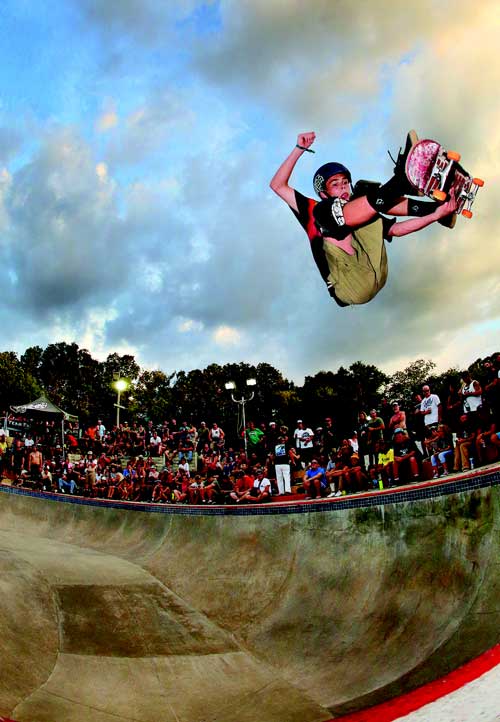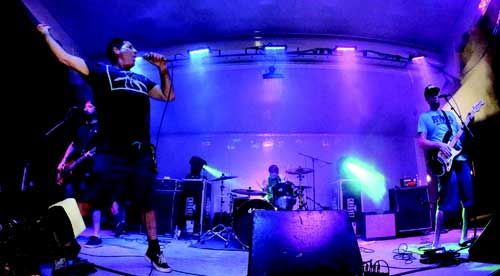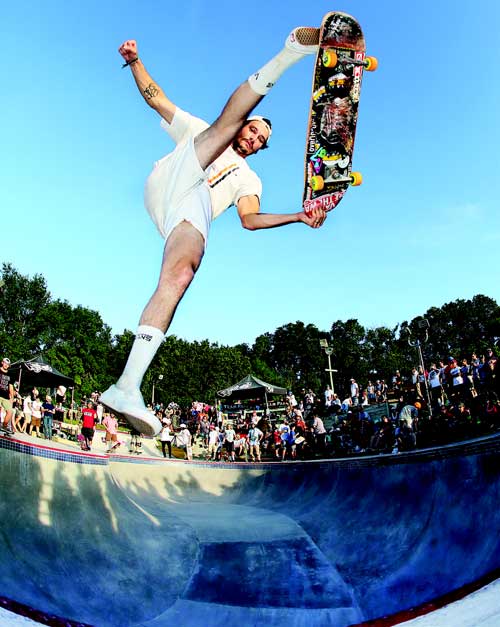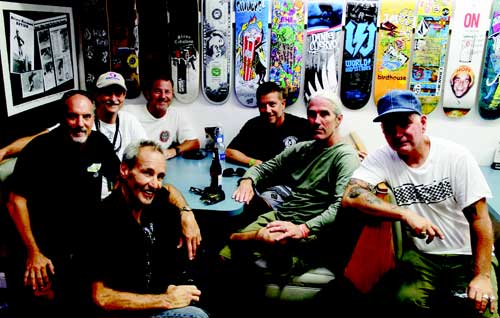




 I first learned about the Kona Skatepark in the pages of SkateBoarder magazine back in the spring of 1977. I was mesmerized by the flowing lines of red, white and blue. The snake run looked positively insane. It would take over 38 years for me to actually set foot in the place. Your first time opening up the door to walk into the park is something no skater ever forgets. You are hit with a wave of concrete.
I first learned about the Kona Skatepark in the pages of SkateBoarder magazine back in the spring of 1977. I was mesmerized by the flowing lines of red, white and blue. The snake run looked positively insane. It would take over 38 years for me to actually set foot in the place. Your first time opening up the door to walk into the park is something no skater ever forgets. You are hit with a wave of concrete.
Kona is the last remaining U.S. skatepark from the 1970s. The fact that it’s located in Jacksonville, Florida, and not some beach town in Southern California speaks volumes. This park has so much history and oozes so much soul, it’s pretty much impossible to capture its essence in eight pages.
In June I was fortunate to attend Kona’s 40th anniversary celebration. Locals, other Floridians and East Coast skaters came out in droves to celebrate. A number of West Coast pros and legends and also made the four-hour-plus flight to be a part of things. It was a skateboard reunion/contest that combined the very best of what skateboarding has to offer.
Florida really turns up the heat from April to October, but that shouldn’t discourage you from visiting. But if you live in a climate like Canada’s, it can take some adjustment. I found myself walking a lot slower and reaching for water every half-hour. Given its location and massive amount of reflective concrete, Kona just bakes in the sun. The heat, however, seems to have no effect whatsoever on the intensity of the skating. In fact, from my three days of observation, the heat just makes skaters charge even harder!
For the generation of skaters who experienced Kona in the 1970s, the park has left an indelible mark on their lives. Mitch Kaufmann, who along with Jimmy Plumer invented the elevator drop, has skated the park since its earliest days. When Kaufmann dropped in from the park’s monolithic Tombstone in a contest, it solidified his reputation as a Kona legend.
“I remember that day clearly,” he recalls. “I was going for the win. I didn’t have that great of a run, and I figured the only way I was going to win was if I did the elevator drop off the Tombstone. I tried it the first time and ate it. I realized that if I just slammed my front wheels down and rode it out I could make it. Looking back, I am not sure how I even made that second run.”
Kaufmann says his favorite memory of Kona is the first month or two before that contest. “It was such a fun scene. It was all so new,” he says. He says he and Plumer couldn’t wait for the concrete to dry onthe Tombstone.
Like Kaufmann, Plumer has ridden at Kona since it started. With roots in both Santa Monica and Jacksonville, Plumer was a key figure in linking the West Coast skate scene to the East Coast. “My favorite memory was when I was 16 and I won the snake run downhill,” he says. “I turned pro that day and made $600.”
I asked Jimmy what his life would have been like if Kona had closed in the 1980s like most other skateparks. “I wouldn’t have had one,” was his reply, echoing the sentiments of a vast number of people.
Another local whose roots go far back to Kona is Hunter Joslin. Hunter is the inventor of the Indo Board, but back in 1978, he was reveling in the experience of having all the West Coast pros meet up at Kona. “All the Dogtown skaters came out and it was unreal,” he says. “It wasn’t East versus West; it was a true skateboard community.”
Legendary skate manufacturer “Professor” Paul Schmitt, who came all the way from California to celebrate, also grew up in Florida and skated Kona. “The first time I came here was 1979,” he says. “I rode a Greyhound bus to Lakeland, Florida. Then I got in the back of a pickup truck [with] a camper shell and that took me to Kona. Walking through the door that first time was an incredible feeling.”
The skating over the weekend at several different parts of Kona was truly epic. From the women and men tearing things up in the pool to the banked slalom race down the snake run, spectators were hit with a wave of pure skate stoke. Watching Tony Alva flow in the pool at close to 60 years of age left a huge impression on everyone. David Hackett charged the snake run with every ounce of intensity he could muster. Pros like Darren Navarrette annihilated the pool along with countless locals and unknowns. But it was Sunday’s Tombstone competition that blew everyone’s minds. After hours and hours of riding, the skaters somehow overcame the heat and exhaustion to take on the giant vertical slab with the kinked transition. Nothing was too outrageous, and Kona fans were treated to a truly world-class session.
Also flying in from California was Steve Alba. I was surprised to learn that this was Salba’s first time riding Kona. “[I’d] been here two times in the ’90s but had busted my fingers, so I couldn’t skate,” he explained. But he added now that he’d returned, “I was so stoked to ride the snake run.”
Dave Duncan has been announcing contests for years and did so for this event. When I noticed he had a free moment, I took my chance to get his thoughts. “This event right here, right now is my favorite memory,” he said. “I’ve seen so much crazy stuff here, it’s been awesome.” Dave grew up skating in the ’70s and enjoyed the snake runs found in so many parks of that era. “There are no more parks like Kona,” he said. “This one has the history, and that’s why I’m here.”
Sharron Brown’s son Jacob is an up-and-coming skater who entered the pool contest. The family lives just outside of Nashville, Tennessee, which means they had a solid 10-hour drive to get to the park. Sharron tells me her husband skated at Kona in the ’80s, and they encouraged Jacob to start skating at the age of 4. It is a true testament to the power of Kona to seamlessly bridge the generations.
Jacksonville is a huge city, boasting an area of almost 900 square miles. Kona is located in an area called Arlington, just near the airport. While I had visited the park before, I hadn’t really gotten to see Jacksonville before this trip. The one word that kept coming back through my mind was “surprising.” For a lot of folks, Florida is Miami Beach and Disney World. But Jacksonville seems to have channeled its inner Austin and San Diego. There are some very cool places that just completely take you by surprise. There are dozens of unique breweries and shops that add a huge amount to the experience.
The restaurants are also exceptionally tasty. We hit a Mexican joint called TacoLu that was absolutely jamming on a Friday afternoon. The food was delicious. I looked up at the ceiling and spotted a Landyachtz deck. Obviously skaters had left their mark.
A recent issue of a local magazine called Jax featured a cover story about the power of skateboarding to change a city, a fitting tribute to the dedicated skaters of Florida. Hopefully, other cities will follow Jacksonville’s lead.
The Ramos family has been associated with Kona for almost four decades. Marty Ramos (the son of longtime owners Helen and Martin) recalls driving with his parents on the highway adjacent to park and watching it being built. “I saw all these tractors making this massive mound of dirt,” he says. “This eventually would turn into the snake run.” It took almost a year for the park to be finished. “When the park eventually opened, my friend and I both had steel-wheel skateboards. We realized we needed to upgrade our equipment for Kona!”
At the time that Kona was built, Arlington was the epicenter of Jacksonville. It had one mall, the Regency. “I stopped going to the roller rink and started skating at the skatepark,” Marty says. Like many skateparks of the 1970s, Kona rode the boom times and then met the bust. Toward the end of that decade, due to a combination of mismanagement and a crash in skateboarding’s popularity, things looked bleak for the health of the park. It eventually closed down in the fall of 1978. Local skaters and BMXers still rode the park when they could by sneaking in through the fence.
In May 1979, the Ramos family purchased the shuttered park, and by June they had Kona up and running again. “My father was an accountant and he had a sense for business,” Marty says. “He had purchased some pool halls and made them financially successful. He was a pretty entrepreneurial guy.”
Marty says that when his father purchased the park from the bank, he figured he’d have it for a few years and then build some apartments on it. “Obviously that did not happen,” Marty now says with a smile.
Despite the family’s passion and business acumen, for a few years, Kona sat pretty much empty. “You have to remember that in 1980, no one really cared about skateboarding,” Marty says. “It was not cool to be a skateboarder at that time.”
But the family persevered, and ultimately Martin Ramos’ investment helped to save the last remaining ’70s skatepark. I asked Marty what he thinks would have happened had the family lived out in California; could they have saved parks like Carlsbad and Spring Valley? “It’s funny, the family almost did move to California,” he says. “My dad was the son of a sharecropper from southern Texas. He faced quite a bit of discrimination because he was half Mexican. He joined the Air Force at a young age to get out of his situation and eventually wound up in Nebraska, where he met my mom. When they got married, they looked at both California and Florida. Florida was the shorter drive, and that’s how they wound up there.” Sadly, Martin Ramos passed away at the age of 62 in 1995. Although he never skated or surfed, he did water ski. “He was not a typical accountant,” Marty says. “He loved the challenge of taking a business that someone had failed at and making it successful.”
At the age of 25, Marty took over running the park. “College was really important to my parents, but skateboarding was a major distraction,” Marty says. “I never grew up thinking I’d take over the park.” But after two attempts at higher education, he eventually secured a degree in business, and he continued in his father’s footsteps.
“My father would put me in some pretty interesting situations,” Marty says. “I remember buying seven suits with my dad. I’d wear the suits while I ran the park. When lunchtime hit, I’d put on my skate clothes and go out and ride. I’d get all sweaty and come back and put on the suit.”
Although California is usually considered the epicenter of skateboarding, it’s not by chance that an East Coast park can lay claim to be the last surviving skatepark of the 1970s. Marty acknowledges that being a skater on the East Coast is a challenge. “You just have to work a lot harder,” says Marty. “I think that’s one of the reasons the park has been around. We didn’t have industry to lean on. There was no one to bankroll the park. If we wanted a contest, we had to put it on ourselves. We just couldn’t wait
for others.”
It is this do-it-yourself attitude that has propelled Kona forward these past four decades. “There just feels like there is a lot more tenacity and determination here on the East Coast,” says Marty.
Marty admits he had a choice when it came to Kona. “I could have walked away, but I didn’t,” he says. “Now I get to build stuff, run contests my own way. It’s just us. Nothing was ever planned, but it all worked out.”
The great thing about Kona and its 40th anniversary celebration is that it truly was a showcase for all types of skateboarding. It was as inclusive as you can get. Besides the banked slalom, vert (featuring some outstanding female riding) and Tombstone events, there was even a contingent of freestyle skaters who busted out some tricks.
Kona now spans two generations of skaters and has solidified its place within skateboarding as an absolute mecca. Fathers who skated Kona in the ’70s now ride with their sons and daughters. “Kona has given the skate world some pretty amazing skaters,” Marty says. “The place is gnarly and it’s high-energy. It’s probably something to do with the heat.”
For the last 40 years, Kona Skatepark in Jacksonville, Florida, has remained a lighthouse for generations of skateboarders to come and test their mettle on its legendary concrete terrain. Kona stands alone in its status as the oldest consecutive-running, privately owned skatepark in North America, making it a historical landmark for skateboarding and also an American treasure. The ironically titled tombstone that sits dead center in the park stands tall as a reminder of the enormous amounts of blood and sweat, poured over a timeline of progression over the last four decades of skateboarding.
Since 1977, skateboarding has constantly challenged all possibilities and Kona has remained a veritable proving ground for the most famous and infamous names in skateboarding to showcase their skills. The Ramos family has weathered many a storm over the years and their unwavering passion and dedication to keeping skateboarding alive is inspirational and unequivocally appreciated by those who show up to ride on a daily basis.
The 40 year celebration of this magical concrete wonderland was nothing short of astonishing. A major tip of the hat to the Ramos family for keeping skateboarding alive and well on the Right Coast for the last four decades and a raise of the glass to many more decades of ripping to come. Thank you to the City of Jacksonville for all of your superb hospitality and much love to all of our skateboard family and friends for an unparalleled weekend of non-stop fun.
